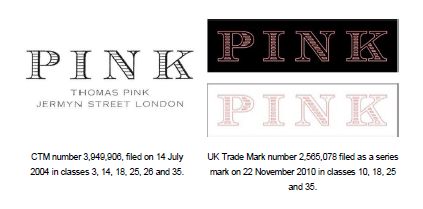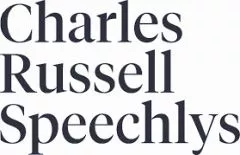On 31 July 2014, Birss J handed down a judgment of the High Court, finding that famous lingerie brand Victoria's Secret had infringed registered trade marks owned by high street shirt retailer, Thomas Pink. The court's judgment considers numerous interesting aspects of trade mark law, including infringement, validity and non-use.
The full judgment is worth a read for those interested and can be accessed here http://www.bailii.org/ew/cases/EWHC/Ch/2014/2631.html.
Birss considered that Thomas Pink's trade marks were infringed, despite the fact that the two brands operate in very different sectors within the fashion industry. This is perhaps a reflection of the fact that fashion brands often diversify their goods into other sectors – Birss acknowledged that perfume and other beauty and personal care products are similar to clothing and accessories. The decision is therefore likely to be welcomed by fashion brands.
Lastly, the case is a relatively rare example of an infringement case in which the judge found that the infringer's use might have a detrimental effect on the repute of the registered trade marks.– The judge said that "[Thomas Pink's] trade mark will be associated with a mass market offering, reducing its luxurious reputation".
The key facts
Thomas Pink has been around since 1984, primarily selling men's shirts (but over time selling other goods such as ties and accessories for men and women). Thomas Pink owned both a Community and UK registered trade mark, details of which are below.

In 2004, Victoria's Secret launched a sub-brand in the UK called PINK, which now has its own PINK branded stores. In 2012, Victoria's Secret opened stores in the UK, selling casual clothing by reference to the PINK name, examples of which are below. Thomas Pink sued for infringement and the key aspects of the decision are set out below.

Non-use
Article 51(1)(a) CTMR states that the rights of the proprietor of a Community trade mark shall be revoked if within a continuous period of 5 years the trade mark has not been put into genuine use in the Community in relation to the goods or services in respect of which it is registered and there are no proper reasons for non-use. In that context, if a trade mark proprietor has made genuine use of their trade mark in relation to some of the goods or services covered by the specification, the registration may be revoked in relation to the remainder of them. Equally, wording in the specification can be amended by the court to arrive at a fair specification.
Victoria's Secret alleged that Thomas Pink was not able to show genuine use of their CTM in relation to numerous goods in classes 3, 14, 18, 35 and 25. The court disagreed in relation to almost all goods which were challenged and only a very small number of goods have been removed from the specification.
Victoria's Secret had attempted to argue that the word "clothing" was not an appropriate or fair description. Birss J rejected the argument that "clothing" was inherently unclear and pointed out that the real question was whether "clothing" was a fair description having regard to the use actually made of the CTM. The judge was satisfied that the range of goods in relation to which the claimant had shown genuine use (including a variety of goods for both the upper and lower body) justified a registration in class 25 with the description "clothing". In relation to footwear, Thomas Pink has used only on wellington boots and the class 25 spec should be amended to wellington boots.
Validity
Whilst Victoria's Secret was successful in arguing that the UK registered trade mark was devoid of distinctive character (on the basis of Section 3(1)(b) and/or 3(1)(c) of the Trade Marks Act), it was open to Thomas Pink to demonstrate that the mark had acquired distinctiveness through use (under the proviso to Section 3(1)). The fact that Thomas Pink had used the mark in forms which were slightly different from the form of the mark shown on the register did not mean that they would not be able to rely on that use for the purposes of demonstrating acquired distinctiveness. The slight alterations in the form used by Thomas Pink did not alter the distinctive character of the mark. The judge rightly observed that "proprietors do not always and consistently use a mark in precisely the form as registered".
Infringement
Thomas Pink alleged that Victoria's Secret infringed both their CTM and UK registered mark on the basis of Article 9(1)(b) CTMR/s.10(2)(b) TMA1 and under Article 9(1)(c) CTMR/s.10(3) TMA2.
Birss J found that Victoria's Secret's use on garments and store fronts (which did not use the mark "PINK" in combination with the mark "Victoria's Secret") infringed Thomas Pink's registered marks. This was on the basis of Article 9(1)(b) CTMR/s.10(2) TMA, which state that a sign will infringe where it is similar to the registered trade mark and goods/services are identical or similar and there is a likelihood of confusion. Thomas Pink had adduced evidence of actual confusion, with members of staff giving evidence of consumers who had confused the two brands in store. Although the evidence was not of significant weight to prove actual confusion, it was sufficient to prevent Victoria's Secret from credibly contending there was no evidence of actual confusion. Nevertheless the judge found that the use of the mark PINK alone by Victoria's Secret was infringing. The marks were similar, the goods were identical or similar and nothing in the context reduced the likelihood of confusion.
The judge found that use of the mark PINK on swing tags on garments sold inside Victoria's Secret's premises did not infringe under Article 9(1)(b) as there was sufficient emphasis on the brand Victoria's Secret to counteract any confusion. But, the Judge then went on to find that this use did infringe under Article 9(1)(c) CTMR/s.10(3) TMA, which can only be used in relation to trade marks which have a "reputation" in the relevant territory. Having established this, the mark will be infringed if a similar sign is used without due cause and that use takes unfair advantage of, or is detrimental to, the distinctive character or the repute of the trade mark.. In this case, all the necessary ingredients were present:
- There was a reputation in the PINK marks in relation to luxury shirts and other clothing;
- The average consumer would perceive a link between the PINK marks and the use of PINK by Victoria's Secret even when used in clearly branded Victoria's Secret stores; and
- The extension of Victoria's Secret USA brand to the EU was without due cause even though not in bad faith – it did not pause to consider Thomas Pink's rights – it simply went ahead.
Birss J did not struggle to find that Thomas Pink's trade marks benefited from this extended protection by virtue of their "major reputation". He went on to determine that Victoria's Secret's use would have a detrimental effect on the repute of Thomas Pink's marks (the Victoria's Secret brand was thought to have been subject of a certain degree of controversy, since it aimed to have "sexy, mass market appeal" and would lead Thomas Pink's marks to be associated with a mass market offering, reducing Thomas Pink's luxurious reputation. In addition, Victoria's Secret's use would also "inevitably cause a detriment to the distinctive character of the claimant's mark".
The only use which the judge found did not infringe was on Victoria's Secret's feedback page which used PINK and Victoria's Secret in combination. It was not targeted at the UK/EU and even if it was, the mark PINK was not shown independently of the mark Victoria's Secret. There was sufficient emphasis on "Victoria's Secret" to avoid a likelihood of confusion. An example of Victoria's Secret's non-infringing use is shown here.

Footnotes
1 Which provides that a mark is infringed where the sign is similar or identical to the registered mark and used in relation to similar goods and services and there exists a likelihood of confusion on the part of the public.
2 Which provides that a mark is infringed where the sign is identical or similar to the trade mark, which has a reputation in the UK (or EU in the case of CTMs) and the use of the sign, being without due cause, takes unfair advantage of, or is detrimental to, the distinctive character or the repute of the trade mark.
The content of this article is intended to provide a general guide to the subject matter. Specialist advice should be sought about your specific circumstances.
[View Source]

